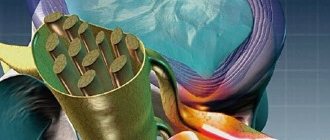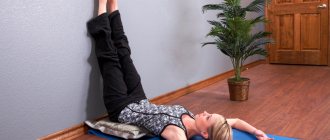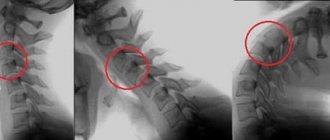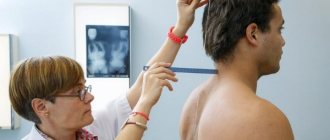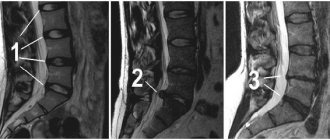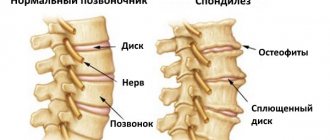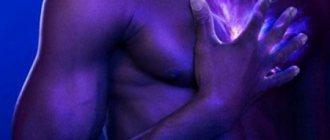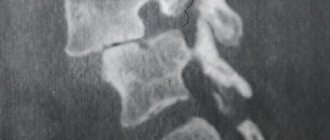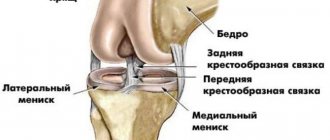Why does the spine need curves?
The expression "straight spine" is not factually correct. If you look from the side at a person with correct posture, you can clearly see certain curves. They are absolutely not associated with any disease, but are fully consistent with physiology and perform a very important function of shock absorption. It allows you to protect parts of the spinal column from serious injuries (fractures, sprains, displacements).
Studying a normally developed spine from the side, looking at it along an imaginary vertical (saggital) plane, you can see:
- Anterior arching in the cervical region. This bend is called cervical lordosis.
- The posterior (backward) bending of the spinal column in the thoracic region forms thoracic kyphosis.
- In the lower back, as in the cervical region, there is an anterior bend, called lumbar lordosis.
- The posterior bend in the sacral region is called sacral kyphosis.
Thanks to kyphosis and lordosis, the spine can withstand an impressive load, eighteen times more than a concrete column of the same thickness. They give the spinal column elasticity, allowing it to be distributed evenly to all parts during heavy loads.
An adult has 2 lordoses - convex in the front and 2 kyphosis - convex in the back, the severity of which depends on the specific distinctive features of each organism.
What role do the curves of the spine play?
Very often people are interested in what role the curves of the spinal column play. Their main task is depreciation, i.e. the correct distribution of loads on the spine. In addition, it eliminates lateral loads, which can cause displacement of the vertebrae and intervertebral discs. Due to physiological curvature, protection from excessive shock to internal organs, the spinal cord and brain occurs, as well as stability and mobility of the body.
Important! If the function of the spinal column is impaired and the angle of bending increases or decreases, then a diagnosis of pathological lordosis or kyphosis is made.
Bend formation time
The first years of a child's life are fundamental at all stages when the curves of the spine are formed. At birth, children have only one physiological sacral kyphosis. Further development proceeds as follows:
- At 2–3 months after birth, the baby begins to lift and hold his head while lying on his stomach. During this period of time, the formation of cervical lordosis occurs.
- Towards the end of the first year, when the baby has already learned to sit, the formation of thoracic kyphosis in the spine ends.
- From the 13th month of life, the formation of a curve in the lumbar region begins. The child can already walk and move more actively, his muscle corset develops and strengthens. This is what makes the formation of lumbar lordosis possible.
The process of formation and development of bends occurs gradually and ends by the age of seven. The correct posture of the child and the absence of such dangerous diagnoses as dysplasia or scoliosis completely depend on how the mother monitors his progress.
Future parents must know:
- How to properly pick up, turn, carry and swaddle a newborn.
- Age for starting to hold the head (after the third week of life).
- When can a child be seated and taught to walk?
There is no need to rush and speed up physiological processes, trying to make a child prodigy out of your baby. Nature has long determined its time for everything to develop properly.
Even in the womb, the curves of the spinal column may undergo improper formation and deformation. The reason for this may be a lack of vitamin D, as well as genetic predisposition. However, if the problem is identified in a timely manner and treated correctly, severe consequences can be avoided in the future.
The structure of various parts of the spine
Depending on its purpose and functionality, each part of the spine has its own structure and structural features.
The cervical spine has the greatest mobility. It is achieved thanks to the unique structure of the first two vertebrae, which are responsible for the ability to turn the head in different directions. Since the force forces during turns are minimal, these vertebrae themselves are narrow and have small bodies. In this part of the spine, intervertebral hernia or osteochondrosis is often diagnosed.
The largest in size is the thoracic region. It is less mobile compared to other sectors. It contains many organs, including the attachment of the ribs. For this reason, the vertebrae of this section are more massive and have larger bodies. Since this department is little involved in movement, the formation of hernias in it is a very rare occurrence.
The heaviest load falls on the lumbar region, which is reflected in the size of the vertebrae in this segment. Here the vertebrae have their greatest diameter and height.
The sacral segment has unique structural features due to the fact that all its vertebrae are a single whole. They have fused into a single structure, with the largest being the first 2 vertebrae of this sector, the following vertebrae being somewhat smaller in size. In the vertebrae of this segment the following are often observed:
- sacralization;
- lumbarization.
Sacralization is a phenomenon that involves the fusion of the 5th lumbar vertebra with the 1st sacral vertebra. Lumbarization is the phenomenon of separation of the 1st and 2nd sacral vertebrae. These processes are not considered pathology.
When pathology occurs, both of the most vulnerable sections usually suffer: the sacral and lumbar, since when the lumbar flexes, most of the load falls on these two sections.
Consequences of improper bending
As a result of a consistently incorrect position of the body or some other reason, the physiological curves of the spine take on an incorrect, painful shape. Then the concepts of lordosis and kyphosis take on a different meaning. These are already the names of diseases associated with curvature and deformation of the spine.
Pathological kyphosis
The diagnosis is made with severe stooping. An incorrectly formed curve in the chest area turns into a hump on the back. This result leads to:
- Formation of degenerative abnormalities.
- Deformed development of vertebrae and tissues.
- Severe spinal injuries.
- Diseases that negatively affect the spinal column (osteoporosis, poliomyelitis, rheumatoid arthritis).
Pathological lordosis
Occurs in the cervical or lumbar regions with a forward curve of the spine (anterior convexity). People who spend a long time in a sitting position are exposed to curvature of the cervical spine. Lordosis in the lower back develops as a result of injuries, severe obesity or the presence of congenital pathologies.
The disease can be identified by the following features:
- The shoulders and head are strongly pushed forward.
- The abdomen protrudes excessively.
- Flattened chest.
- The knees are strongly turned to the sides.
With advanced forms of kyphosis and lordosis, severe unbearable back pain appears. Also, these diseases are characterized by serious changes in the normal functioning of internal organs, and their deformation and displacement are also very often observed.
Scoliosis
This is another serious disease associated with curvature of the spinal column. It is acquired and occurs as a result of constantly incorrect posture. As a rule, this disease is from childhood. It develops when a child sits heavily bent over, regularly carries a school bag on one shoulder, or slouches, having a complex about being tall or overweight.
According to statistics, scoliosis affects 80% of children under the age of 16 years. It's alarming that this is not the limit yet. This figure continues to grow rapidly “thanks” to computers, on which children spend more than the majority of their time. This is very dangerous from a medical point of view. Parents are simply obliged to regulate children's leisure, otherwise the pathology can lead to disability.
A timely visit to a specialist will help you and your children avoid serious pathologies associated with curvatures of the spine. A good doctor will help you choose an individual set of physical therapy sessions and adjust your lifestyle in the right direction.
The structure of the spine and its functions
The components of the spine, in addition to all the vertebrae connected to each other, are the area of the coccyx and the sacrum, held together by cartilage and ligaments. The anatomy of the spine is quite simple. It consists of 31-37 vertebrae, their number varies depending on the number of vertebrae in the coccyx area. The length of the spine at a young age is slightly longer. For example, in boys its length ranges from 72 to 76 cm, and in girls from 68 to 71 cm. With age, the spine shortens by approximately 4-8 cm. This shortening occurs as a result of atrophy of the discs located between the vertebrae.
Main functions of the spine:
- motor;
- depreciation;
- supporting;
- protective.
The entire skeleton (limbs, skull, hip joint and rib cage) is attached to the spine. It is responsible for the correct location of all internal organs. All vertebrae are connected to each other through:
- ligaments;
- tendons;
- facet joints;
- intervertebral discs.
The functions of the spine are distributed so that each connecting element has its own purpose.
- Ligaments are designed to connect the vertebrae.
- Tendons attach the paravertebral muscles to the spine.
- The mobility of the vertebrae is ensured by the facet joints.
- Shock absorption and load regulation are carried out through intervertebral discs.
The condition of the discs and vertebrae affects the health and strength of the entire spinal system. If they are deformed, diseases of the ligaments, tendons and muscles may occur, and there is a high risk of diseases of the muscular-ligamentous corset.
When does the normal curvature of the spinal column form?
Many people ask the question: “How many curves does the human spine have?” There are 4 types of physiological curvature of the spine. When a person is born, he has only a single kyphosis in the sacral region. During the development of a child, three more physiological curves of the spine are formed:
- from 2 to 3 months, the baby learns to hold its head by raising and lowering it. Thus, cervical lordosis begins to form;
- by 11–12 months, when the child sits well and can stand independently, kyphosis of the thoracic region forms;
- starting from the age of one, a deflection of the lumbar region appears with a convexity forward. At about 13 months, most children begin to walk and move actively, resulting in a strong corset of skeletal muscles. Lumbar lordosis is formed.
To avoid pathological curvature of the spinal column in a person, it is necessary not to rush things, that is, do not try to sit the baby up or put him on his feet before the due date. The natural curves of the spinal column stop forming by the age of seven. It is very important to monitor the correct posture of children in order to prevent the development of serious diseases such as scoliosis, pathological lordosis and dysplasia.
Interestingly, while still in the womb, the child may begin to develop abnormal curves in the spine, leading to deformation of the vertebrae. Why might this happen? Most often this is due to heredity or vitamin D deficiency. But despite this, early detection of pathology helps prevent the formation of serious and irreversible consequences.
Incorrect formation of bends
Sometimes, for some reason, pathological curves of the body may develop. Then lordosis and kyphosis are perceived as serious diseases of the musculoskeletal system and require immediate treatment.
Pathological lordosis
This is the name of a pathology in which the spinal column is convex forward. It can develop at any age due to acquired or congenital anomalies of the vertebrae, hip joints, spinal, femoral and gluteal muscles, oncological intervertebral neoplasms, spinal injuries, certain diseases (poliomyelitis), the period of gestation. In the latter situation, lordosis is temporary and will completely disappear when the child is born.
Necessary measures for correct posture
All people with pathological curvature of the spinal column must be monitored by an orthopedist-traumatologist. In turn, the doctor must prescribe all possible procedures aimed at eliminating the diseases: massage, physical therapy, orthopedic supplies, manuals, manual therapy, physiotherapy, etc. are prescribed. In severe cases, surgical treatment is indicated.
As measures aimed against the development or progression of scoliosis, kyphosis and lordosis, it is necessary to carry out comprehensive measures:
- sleep on a hard bed on an adjustable mattress, in a position on your back or stomach;
- wearing orthopedic shoes or inserts in the form of insoles with an anatomical structure;
- physical labor: swimming, athletics, tourism and others;
- strict adherence to the daily routine (getting up and going to bed at the same time, eating);
- giving up bad habits (smoking, alcohol abuse, drug addiction). Other bad habits include avoiding certain incorrect positions, such as sitting cross-legged or standing on one leg;
- self-monitoring of correct posture during sedentary work, at a school desk, at home on a chair, etc.;
- wearing special equipment, corsets and other accessories in case of violation of the normal curvature of the spinal column to fix it;
- uniform distribution of the load on the spine when carrying bags, backpacks, briefcases.
Parents need to monitor the health of their children at any age. It is from adolescence that pathological curves of the spine most often form. If you do not notice this in time, the diseases will progress, bringing a lot of discomfort and health problems.
